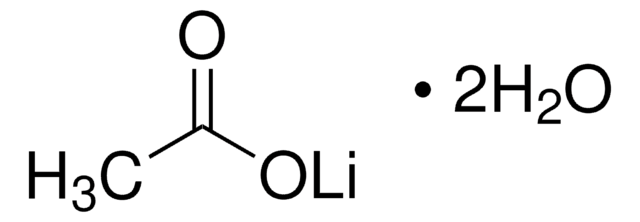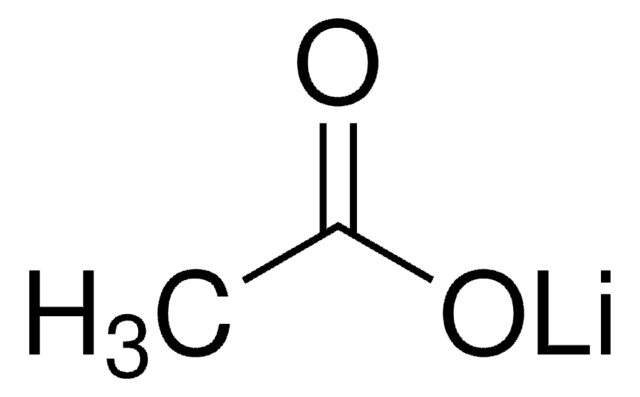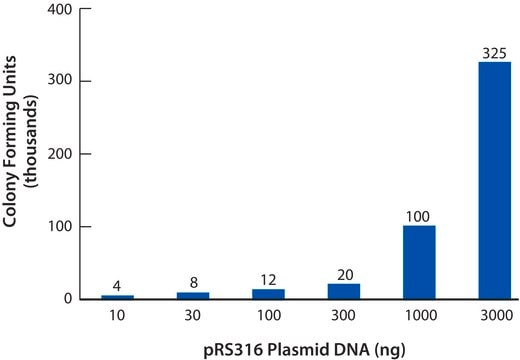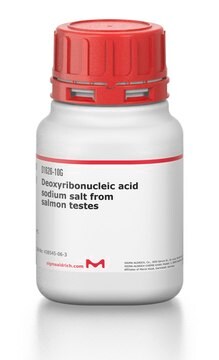L6883
Lithium acetate dihydrate
reagent grade
Synonym(s):
Acetic acid lithium salt
Sign Into View Organizational & Contract Pricing
All Photos(3)
About This Item
Linear Formula:
CH3COOLi · 2H2O
CAS Number:
Molecular Weight:
102.02
Beilstein:
3564320
EC Number:
MDL number:
UNSPSC Code:
12352302
PubChem Substance ID:
NACRES:
NA.55
grade:
reagent grade
form:
solid
Recommended Products
grade
reagent grade
Quality Level
form
solid
composition
Lithium acetate, ≥63%
pH
≤9.5 (5% in solution)
mp
53-56 °C (lit.)
anion traces
chloride (Cl-): ≤0.003%
sulfate (SO42-): ≤100 ppm
cation traces
Fe: ≤20 ppm
Na: ≤50 ppm
SMILES string
[Li+].[H]O[H].[H]O[H].CC([O-])=O
InChI
1S/C2H4O2.Li.2H2O/c1-2(3)4;;;/h1H3,(H,3,4);;2*1H2/q;+1;;/p-1
InChI key
IAQLJCYTGRMXMA-UHFFFAOYSA-M
Looking for similar products? Visit Product Comparison Guide
Related Categories
General description
Lithium acetate dihydrate is one of the commercially available forms of lithium acetate. It is used as a precursor material for the synthesis of various lithium-based compounds. It is also used as a catalyst in several chemical reactions.
Application
Lithium acetate dihydrate (LiOAc.2H2O) can be used as a precursor material to synthesize:
It can also be used as a catalyst in the enantioselective synthesis of functionalized 1,3-thiazin-4-ones via N-heterocyclic carbene (NHC)-catalyzed [3 + 3] annulation of thioamides.
- Carbon-modified nanocrystalline LiFePO4 (LiFePO4/C) via sol-gel method using ferrous sulfate, phosphoric acid, citric acid, and polyethylene glycol.
- Lithium-graphite nanotubes (LGN) by chemical vapor deposition (CVD) method in the presence of copper with methane as the carbon source.
- Conductive polycrystalline solid-state electrolyte (Li4B7O12Cl) by reacting with boric acid and copper(II) chloride dihydrate in trihexyltetradecylphosphonium chloride via an ionothermal method.
It can also be used as a catalyst in the enantioselective synthesis of functionalized 1,3-thiazin-4-ones via N-heterocyclic carbene (NHC)-catalyzed [3 + 3] annulation of thioamides.
Storage Class Code
11 - Combustible Solids
WGK
WGK 1
Flash Point(F)
Not applicable
Flash Point(C)
Not applicable
Choose from one of the most recent versions:
Already Own This Product?
Find documentation for the products that you have recently purchased in the Document Library.
Customers Also Viewed
Evelina Tutucci et al.
Nature protocols, 13(10), 2268-2296 (2018-09-16)
The MS2 system has been widely used, in organisms ranging from bacteria to higher eukaryotes, to image single mRNAs in intact cells with high precision. We have recently re-engineered the MS2 system for accurate detection of mRNAs in living Saccharomyces
Wenyi Hua et al.
Journal of chromatography. B, Analytical technologies in the biomedical and life sciences, 969, 117-122 (2014-08-30)
A highly sensitive, selective, and rugged quantification method was developed and validated for decitabine (5-aza-2'-deoxycytidine) in human plasma treated with 100μg/mL of tetrahydrouridine (THU). Chromatographic separation was accomplished using hydrophilic interaction liquid chromatography (HILIC) and detection used electrospray ionization (ESI)
Tomasz Krawczyk
Rapid communications in mass spectrometry : RCM, 29(23), 2257-2262 (2015-11-03)
Hexamethylene triperoxide diamine (HMTD) is one of the peroxide-based explosives that are difficult to detect using standard analytical methodologies. It was analyzed by electrospray ionization mass spectrometry (ESI-MS) on a UPLC-TOF instrument. Alkali metal salts were used to promote the
Zico Alaia Akbar et al.
Optics express, 23(19), A1280-A1287 (2015-09-26)
A unique, hierarchically structured, aggregated TiO(2) nanowire (A-TiO(2)-nw) is prepared by solvothermal synthesis and used as a dual-functioning photoelectrode in dye-sensitized solar cells (DSSCs). The A-TiO(2)-nw shows improved light scattering compared to conventional TiO(2) nanoparticles (TiO(2)-np) and dramatically enhanced dye
Elaine L Ferguson et al.
Molecular pharmaceutics, 11(12), 4437-4447 (2014-11-02)
Polymer therapeutics offer potential benefits in the treatment of multidrug resistant (MDR) infections; affording targeted delivery of biologically active agents to the site of inflammation, potential decreases in systemic toxicity, and the retention of antimicrobial activity at the target site.
Our team of scientists has experience in all areas of research including Life Science, Material Science, Chemical Synthesis, Chromatography, Analytical and many others.
Contact Technical Service







